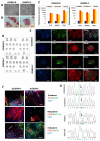IPSC-Derived Astrocytes Contribute to In Vitro Modeling of Parkinson's Disease Caused by the GBA1 N370S Mutation
- PMID: 38203497
- PMCID: PMC10779194
- DOI: 10.3390/ijms25010327
IPSC-Derived Astrocytes Contribute to In Vitro Modeling of Parkinson's Disease Caused by the GBA1 N370S Mutation
Abstract
Parkinson's disease (PD) is a neurodegenerative disorder that ranks second in prevalence after Alzheimer's disease. The number of PD diagnoses increases annually. Nevertheless, modern PD treatments merely mitigate symptoms rather than preventing neurodegeneration progression. The creation of an appropriate model to thoroughly study the mechanisms of PD pathogenesis remains a current challenge in biomedicine. Recently, there has been an increase in data regarding the involvement of not only dopaminergic neurons of the substantia nigra but also astrocytes in the pathogenesis of PD. Cell models based on induced pluripotent stem cells (iPSCs) and their differentiated derivatives are a useful tool for studying the contribution and interaction of these two cell types in PD. Here, we generated two iPSC lines, ICGi034-B and ICGi034-C, by reprogramming peripheral blood mononuclear cells of a patient with a heterozygous mutation c.1226A>G (p.N370S) in the GBA1 gene by non-integrating episomal vectors encoding OCT4, KLF4, L-MYC, SOX2, LIN28, and mp53DD. The iPSC lines demonstrate the expression of pluripotency markers and are capable of differentiating into three germ layers. We differentiated the ICGi034-B and ICGi034-C iPSC lines into astrocytes. This resulting cell model can be used to study the involvement of astrocytes in the pathogenesis of GBA-associated PD.
Keywords: GBA1; Parkinson’s disease; astrocytes; induced pluripotent stem cells.
Conflict of interest statement
The authors declare no conflicts of interest.
Figures


Similar articles
-
Generation of induced pluripotent stem cell line, ICGi034-A, by reprogramming peripheral blood mononuclear cells from a patient with Parkinson's disease associated with GBA mutation.Stem Cell Res. 2022 Mar;59:102651. doi: 10.1016/j.scr.2021.102651. Epub 2021 Dec 31. Stem Cell Res. 2022. PMID: 35007918
-
Generation and characterisation of seven induced pluripotent stem cell lines from two patients with Parkinson's disease carrying the pathological variant c.1087G>T of the LGR4 gene.Vavilovskii Zhurnal Genet Selektsii. 2025 Feb;29(1):15-25. doi: 10.18699/vjgb-25-03. Vavilovskii Zhurnal Genet Selektsii. 2025. PMID: 40144372 Free PMC article.
-
Generation of induced pluripotent stem cell line (ZZUi007-A) from a 52-year-old patient with a novel CHCHD2 gene mutation in Parkinson's disease.Stem Cell Res. 2018 Oct;32:87-90. doi: 10.1016/j.scr.2018.08.011. Epub 2018 Aug 23. Stem Cell Res. 2018. PMID: 30237140
-
Treatment of Parkinson's Disease through Personalized Medicine and Induced Pluripotent Stem Cells.Cells. 2019 Jan 7;8(1):26. doi: 10.3390/cells8010026. Cells. 2019. PMID: 30621042 Free PMC article. Review.
-
Induced pluripotent stem cells: a tool for modeling Parkinson's disease.Trends Neurosci. 2022 Aug;45(8):608-620. doi: 10.1016/j.tins.2022.05.001. Epub 2022 Jun 3. Trends Neurosci. 2022. PMID: 35667922 Free PMC article. Review.
Cited by
-
Detection of ER Stress in iPSC-Derived Neurons Carrying the p.N370S Mutation in the GBA1 Gene.Biomedicines. 2024 Mar 27;12(4):744. doi: 10.3390/biomedicines12040744. Biomedicines. 2024. PMID: 38672099 Free PMC article.
-
Two- and Three-Dimensional In Vitro Models of Parkinson's and Alzheimer's Diseases: State-of-the-Art and Applications.Int J Mol Sci. 2025 Jan 13;26(2):620. doi: 10.3390/ijms26020620. Int J Mol Sci. 2025. PMID: 39859333 Free PMC article. Review.
-
Clinical, mechanistic, biomarker, and therapeutic advances in GBA1-associated Parkinson's disease.Transl Neurodegener. 2024 Sep 12;13(1):48. doi: 10.1186/s40035-024-00437-6. Transl Neurodegener. 2024. PMID: 39267121 Free PMC article. Review.
-
Experimental Cell Models for Investigating Neurodegenerative Diseases.Int J Mol Sci. 2024 Sep 9;25(17):9747. doi: 10.3390/ijms25179747. Int J Mol Sci. 2024. PMID: 39273694 Free PMC article. Review.
References
MeSH terms
Substances
Grants and funding
LinkOut - more resources
Full Text Sources
Medical
Research Materials

